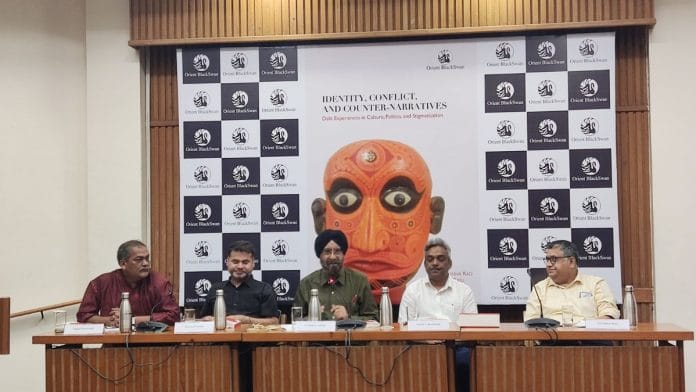New Delhi: A verdict awaited at the India International Centre on 24 April as academicians Yagati Chinna Rao and Raj Sekhar Basu placed the volume, Identity, Conflict, and Counter-narratives: Dalit Experiences in Culture, Politics, and Stigmatisation, before a panel of academics. But in conversation, the rather scholarly discussion looked more like a reunion of old friends from a counterculture movement.
The book itself is countercultural. Unlike most works that frame Dalit history solely through the lens of oppression, Identity, Conflict, and Counter-narratives explores the diverse roles Dalits have played as artists, soldiers, political actors, and cultural thinkers across regional histories. Through ten essays, it urges a methodological shift in how caste and marginality are studied. The book has been edited by Rao, who teaches at the Centre for the Study of Exclusion and Inclusive Policy, Jawaharlal Nehru University (JNU), and Basu, a history professor at the University of Calcutta.
The discussion was chaired by Surinder S Jodhka, a professor at JNU’s School of Social Sciences, with panellists Harish S Wankhede from the same school and Brahma Prakash from the School of Arts and Aesthetics. The book was dedicated to historian Sabyasachi Bhattacharya, who created a space for the study of caste and Dalit history. Some years before his death in 2019, the historian also encouraged Rao to organise the now-recognised Dalit history panel at the Indian History Congress.
The audience in the hall was a mix of academics and students, old and young. Several students of history waited patiently to hear from the panel, the book in their hands.
Dalit art
The comments on the volume began with Brahma Prakash. He reflected on how the meanings of the term ‘Dalit’ have shifted over time, from a marker of oppression to one of cultural assertion. He pointed to the recent rise of ‘Dalit pop’ and how younger generations are reimagining identity, embracing genres like science fiction and speculative literature.
“You have a future generation, they are moving towards various genres. That we want not only to be limited to one genre, we want to perhaps experience or experiment with all these possible genres.” Prakash also talked about how traditional Dalit performance forms like Theyyam are moving from spaces of ritual obligation into the realm of commercial art.
“Art is making a departure from obligation kinds of services to maybe market kinds of services,” he said, observing how this shift is often criticised as decontextualisation. But for younger artists, he argued, that very distance can be liberating.
“Decontextualisation also becomes a political act because precisely you don’t want to go to the context again,” he added.
Prakash concluded his speech with a quick, honest admission. “I would accept that in this book, many things are so complex that I would not understand,” he said, prompting laughter from the panel and the audience alike.
Also read: Bengal’s bhadralok shut out Dalit literature for decades. The monopoly is now cracking
History is a political project
Harish S Wankhede praised the book as it challenges both the sociological stereotype of Dalits as passive victims and the assumption that caste operates in uniform ways across India.
“There is nothing called universal application to Dalit identity. There are multiple nuances,” he said, pointing to the book’s focus on regional histories that reveal how Dalit identity is variedly shaped. Wankhede remarked that writing history is a political project rather than just an intellectual or academic one.
“From Phule to Ambedkar, both utilise the idea of history—that it is crucial for the emancipation and enlightenment of the masses,” he added. “It is a tool that can be utilised to make people aware of their belongingness.”
Praising a chapter on Dalits being a martial race, he drew a parallel with Ambedkar’s own framing that Dalits have historically been more than just poor and marginalised. They have been “intellectuals, kings, and warriors”.
While commending the volume as “extremely comprehensive”, he suggested that including a chapter on Maharashtra’s rich anti-caste history in the book would’ve made for a better, more impressive reading. He proposed, half-jokingly, that a second volume should take on that task.
“Professor Chinna Rao is definitely capable of that,” he added with a grin.
Also read: BJP-RSS want to erase Dalit-Bahujan history at every step: Rahul on ‘Phule’ row
A structure of humiliation
Surinder S Jodhka delivered a sharp critique of Brahminism in social sciences and how caste is approached in academia and public discourse.
“How does one explain the absence of caste in historical scholarship? And I think that’s where this book also makes a very significant contribution,” he said.
Jodhka underscored the reluctance of scholars, both on the Left and Right, to engage with caste seriously. While the Left downplays it in favour of class, the Right sees nothing wrong with it.
He called caste a “structure of humiliation”, arguing that its core is not ritual, but the violence of untouchability and inequality. He criticised the Brahmin-centric and culture-obsessed framing of caste in both Indian and global academia.
Instead, the professor urged a shift toward understanding caste through material realities. “Materiality doesn’t mean class, materiality means the kind of resources that you grow up with, the kind of resources that you have at your command at the moment, the kind of resources that are available for you without your asking for it,” he added.
Jodhka also called for a retelling of Dalit history that embraces the fluidity and regional variation of caste.
“Only through history can we move forward,” he said.
(Edited by Prasanna Bachchhav)






